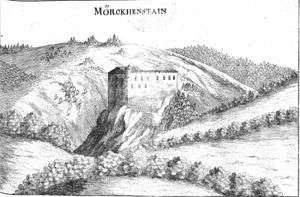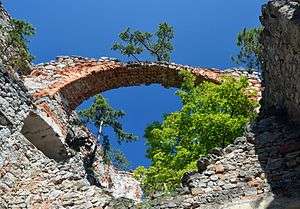Merkenstein ruins
| Merkenstein ruins | |
|---|---|
| Ruine Merkenstein | |
|
Engraving of Merkenstein in 1670 by Georg Matthäus Vischer | |
|
An arch in the Merkenstein ruin, photographed in 2012 | |
| Coordinates | 47°58′56″N 16°08′01″E / 47.98226°N 16.13364°ECoordinates: 47°58′56″N 16°08′01″E / 47.98226°N 16.13364°E |
| Site information | |
| Owner | Austrian government |
| Open to the public | Yes |
| Condition | ruin |
| Site history | |
| Built | Before 1166 |
The Merkenstein ruins are the remains of a castle in Lower Austria near Bad Vöslau in the Großau cadastre (property register). In some sources, it is mentioned as early as the year 1141. The first definite mention is in the Codex Falkensteinensis in 1170. Ludwig van Beethoven dedicated two Lieder to the ruin.
History
In 1486, the castle was captured by king Matthias Corvinus of Hungary. After this period, it was managed by imperial guardians; from 1603 to 1672 it was owned by the Heißperger family, and afterwards by the Dietrichstein family. In 1683 the castle was taken over and destroyed by Ottoman troops.[1]
In the 1600s, Merkenstein controlled Gainfarn, Großau, Pottenstein, Furth, Muggendorf and St. Veit.
Besides the much younger Schloss Merkenstein, about 40% of the Großau congregation belonged to Merkenstein. Until the end of World War II, the castle and its precinct belonged to the Krupp family. After the war it fell under the control of the Administration for Soviet Property in Austria, as German property. In accordance with the Austrian State Treaty, the castle became the property of the Austrian state, controlled by the Austrian national parks service.
In October 2008, the Austrian TV crime drama Vier Frauen und ein Todesfall (Four Women and a Funeral) was filmed at the ruin.[2]
Pictures
 View of the ruin from the Großau – Schwarzensee road
View of the ruin from the Großau – Schwarzensee road View of the ruin from the access road
View of the ruin from the access road
References
- ↑ Dehio-Handbuch Niederösterreich südlich der Donau, 2003, Verlag Berger, Horn/Wien, ISBN 3-85028-364-X, p. 142
- ↑ Vienna Press Picture Agency
Further reading
- Johann Redl, Merkenstein. Die Geschichte der Burgruine, des Schlosses & der Herrschaft Merkenstein. Eine Zusammenstellung Stadtgemeinde Bad Vöslau, 2008
External links
![]() Media related to Burg Merkenstein at Wikimedia Commons
Media related to Burg Merkenstein at Wikimedia Commons
- Ruine Merkenstein at Tiscover

